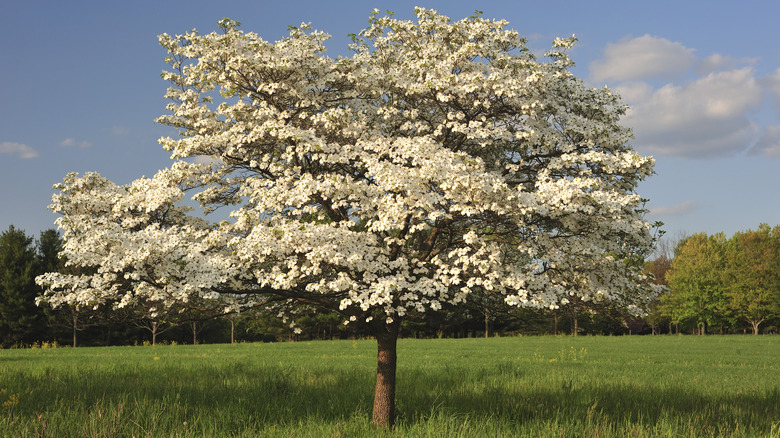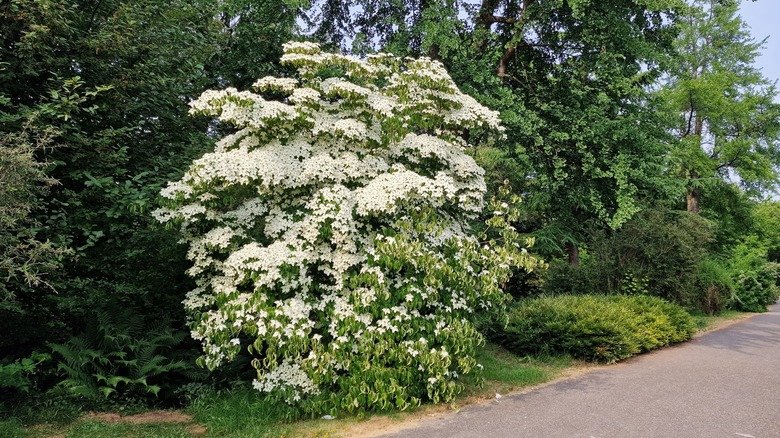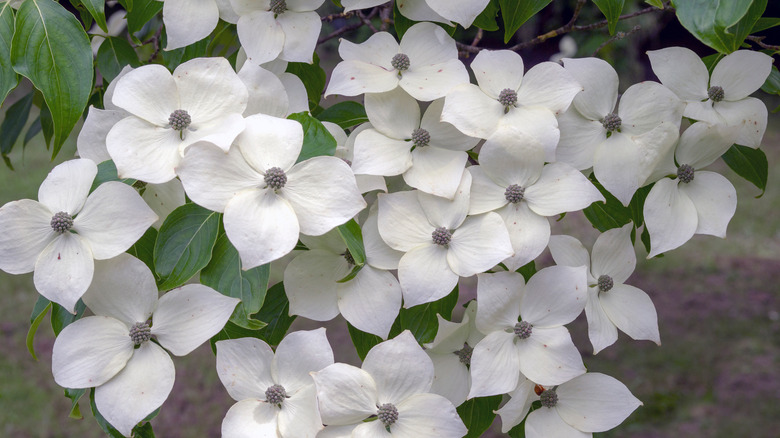The Best Spot To Plant A Flowering Dogwood Tree For Stunning Spring Blooms
There is something incredibly stunning about the cloud-like blooms that grow from the flowering dogwood tree (Cornus florida). These snowy white, flower-like blooms emerge in early spring before the tree leaves develop into a soft green color. These trees, which do best in hardiness zones 5 to 9, will dazzle again in the fall when the leaves turn to a bright purple-to-red color before the cold weather arrives. But growing and caring for dogwood trees can be tricky. To get the most out of these beautiful colors in the spring, you need to know the best spot to start.
The flowering dogwood is a rather versatile ornamental tree, but your chosen location should still check a few boxes. This species needs a good source of regular water, and it tends to do best in consistently moist soil. Also important to consider is the size. Flowering dogwoods typically grow from 15 to 50 feet in height and tend to be wide in some areas. Be sure to plant this tree somewhere it can spread out and create those stunning blooms all spring long.
There are also a few hidden downsides to planting a dogwood tree in your yard, including a slow and sometimes unpredictable growth of 1 to 2 feet per year. That means you'll need to be patient and willing to work around the tree's eventual growth patterns. Before investing in a flowering dogwood, make sure you can give it the best environment and the right support.
Shade - and maybe a shade tree
Flowering dogwood does best in partial (or dappled) shade. That means that if you have a taller tree in your yard, position the dogwood so it receives filtered light through that tree's leaves. This can also help protect those springtime blooms from direct, intense heat. If you don't have a tall tree like this, consider any structures around your home — like the patio awning or even the home itself — that could offer some filtration protection. Flowering dogwoods will also do well next to the patio or even along the border of your yard, where it gets some light protection from the neighbor's tree.
If you have the space in your yard, consider planting a fast-growing shade tree. The shade tree — like the Royal Empress (Paulownia tomentosa), which grows 15 feet per year — will likely grow at a much faster rate than your dogwood and ultimately provide a much higher level of shade and protection over time.
Caring for your spring blooms
To support those beautiful spring blooms, your flowering dogwood tree needs careful attention throughout the year. Start with the soil. This tree does well with slightly acidic and clay soil, and you can definitely add organic nutrients to support the soil quality. The one thing that this tree will demand, though, is both good moisture and excellent drainage. If the roots sit in water for too long, they will develop fungal concerns. However, you also don't want them to dry out. Because they have shallow roots, they need to be watered routinely — at least twice a week — to keep them moist. If you have a stream or a wetter area of your yard, consider placing the dogwood there to keep it watered properly.
Another important tip regards pruning — they don't need a lot. The best time to prune your dogwood is actually super early in the spring before the blooms begin to sprout or in the late winter after the tree enters its dormant period. At the same time, make sure you prune the tree lightly. Too much pruning can ruin that beautiful shape and alter the overall aesthetic value it brings to your home's landscape. In this environment, and with fertilizing as needed to boost soil quality, you'll have a fabulous spring bloom.


